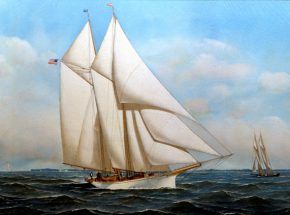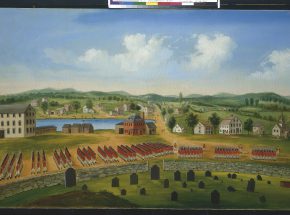

Born July 26, 1796 in Wilkes-Barre, PA, Catlin became a lawyer to please his father, but soon devoted himself to his true calling as an artist. He attended the Pennsylvania Academy of Fine Arts and operated a portrait studio until traveling to Missouri in 1830 to indulge his fascination with the American Indian. Upon arriving in St. Louis, Catlin met General William Clark and made the first of several trips to the upper Missouri where he painted portraits of Indians he met and customs he observed.
Catlin was among the first American artists to visit and depict the Plains Indians. As evidence of his dedication to creating a visual record of the tribes, Catlin spent some eight years traveling among the forty-eight North American Indian tribes. During the 1830’s, Catlin worked at creating finished paintings based on the sketches he had made, and in 1839 he opened an Indian Gallery in London comprised of his paintings along with artifacts he had gathered. In 1844, Catlin issued ‘The North American Indian Portfolio’ featuring lithographs with subjects ranging from individual and group portraits to scenes of tribal ceremonies and events of everyday life. After six years, he reopened his gallery in Paris, but eventually interest dwindled. For years, Catlin tried in vain to interest the U.S. Government in his collection. He died in obscurity on December 23, 1872.
In addition to documenting the lives of the native peoples, Catlin’s sketches and paintings of the Midwest provided the first and most important record of land west of the Mississippi River before white settlement. While living in St. Louis, Catlin created an oil painting depicting the city in 1832. Some thirty years later, the St. Louis Mercantile Library issued a series of lithographs based on the painting. The work exhibited here is from that original series and has been in the Library’s collection since it was printed. The image documents the early development of the city, and the prominently placed riverboat emphasizes the importance of the city’s location at the confluence of the Mississippi and Missouri Rivers. It is natural that the leaders of the Mercantile Library, themselves merchants whose livelihood depended on the transportation of goods along the rivers, would select such an image for reproduction.
Website
http://www.georgecatlin.org

